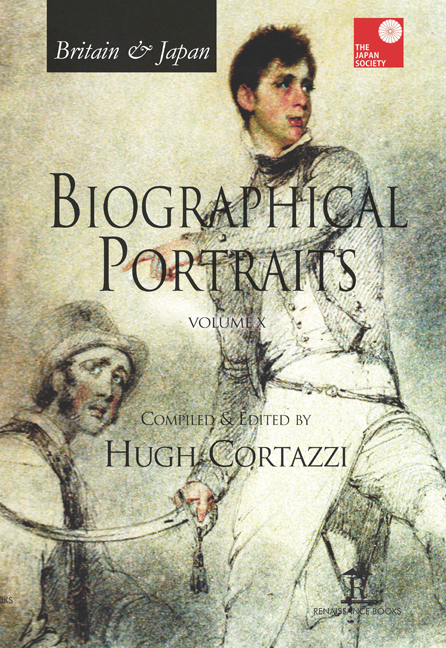Book contents
- Frontmatter
- Dedication
- Contents
- Introduction
- List of Contributors
- Index of Biographical Portraits in Japan Society Volumes
- PART I BRITAIN IN JAPAN
- PART II JAPAN IN BRITAIN
- Select Bibliography of Works in English on Anglo-Japanese Relations [Compiled by Gill Goddard – Retired East Asian Studies Librarian, University of Sheffield]
- Select Bibliography of Works in Japanese on Anglo-Japanese Relations [Compiled by Akira Hirano, SISJAC]
- Index
3 - Victoria Crosses Awarded for Valour in Japan: Duncan Boyes, Thomas Pride, William Seeley and Robert Gray
Published online by Cambridge University Press: 07 May 2022
- Frontmatter
- Dedication
- Contents
- Introduction
- List of Contributors
- Index of Biographical Portraits in Japan Society Volumes
- PART I BRITAIN IN JAPAN
- PART II JAPAN IN BRITAIN
- Select Bibliography of Works in English on Anglo-Japanese Relations [Compiled by Gill Goddard – Retired East Asian Studies Librarian, University of Sheffield]
- Select Bibliography of Works in Japanese on Anglo-Japanese Relations [Compiled by Akira Hirano, SISJAC]
- Index
Summary
INTRODUCTION
THE VICTORIA CROSS (V.C.) is Britain's highest military decoration, awarded for valour ‘in the face of the enemy’. It may be awarded to a person of any military rank, and to civilians under military command. It is first in the order of wear of decorations. There have been four V.C.s awarded for action in Japan, though only two have been awarded to Britons: Duncan Boyes and Thomas Pride. The other two were awarded to an American (William Seeley) and a Canadian (Robert Gray), and as such they could not be subjects for portraits within the criteria for the Britain & Japan: Biographical Portraits series.
This essay focuses on Duncan Boyes V.C., being the best known – and arguably most tragic – of the quartet. It will not go into the reasons for the naval bombardment of Kagoshima (1863) and the naval and military action at Shimonoseki (1864), which have been fully explained and discussed elsewhere.
DUNCAN BOYES (1846–69)
Duncan Gordon Boyes was born at 3 Paragon Buildings, Bath Road, Cheltenham, Gloucestershire, the son of John Boyes on 5 November 1846. His sister Louisa Mary was later to marry Thomas James Young, who won a V.C. at Lucknow during the Indian Mutiny on 16 November 1857. Duncan was educated at Cheltenham College (founded 1841), noted for its classical and military traditions. From there he joined the Royal Navy via North Grove House Academy. He was first assigned to HMS Euryalus on the East Indies station.
Duncan Boyes was a midshipman throughout his brief naval career. This rank has no equivalent in the other two services. It is an officer’s rank, above naval cadet and below sub-lieutenant. In effect it is an ‘officer-in-training’, and Boyes would have expected promotion in due course, regardless of his glorious feat performed at the age of seventeen. Depending on the size of the unit to which a midshipman (‘middy’ in the jargon of the period) is attached, he may mess in the officer's wardroom in a small ship, or with the lower ranks in a larger ship such as the HMS Euryalus.
There have so far been six Royal Navy ships named Euryalus after one of Jason's Argonauts.
- Type
- Chapter
- Information
- Britain & Japan Biographical Portraits Vol X , pp. 37 - 44Publisher: Amsterdam University PressPrint publication year: 2016



